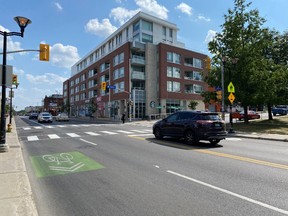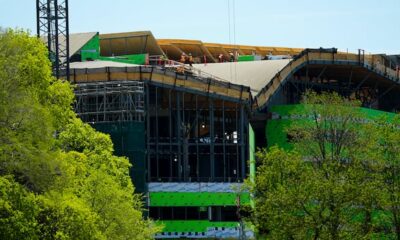Health
Ottawa Champions 15-Minute Neighbourhoods to Enhance Living

Urban planners in Ottawa are increasingly advocating for the development of “15-minute neighbourhoods,” where residents have access to essential services within a short walk or bike ride. The City of Ottawa has incorporated this concept into its Official Plan, aiming to create communities where basic amenities—such as shops, schools, medical facilities, and recreational spaces—are reachable in 15 minutes or less.
According to Royce Fu, the City’s manager of policy planning, the 15-minute neighbourhoods align with Ottawa’s strategic goals, including economic development and climate change mitigation. He stated, “Fifteen-minute neighbourhoods are also key to building healthier and more resilient communities.” This planning model prioritizes high population density and infrastructure that supports walking and cycling, featuring elements like sidewalks, greenery, and adequate street lighting.
Historical Context and Global Influence
The notion of 15-minute neighbourhoods is not entirely new. The concept gained traction after Paris professor Carlos Moreno introduced it during a TED talk in 2015, which was further popularized by Paris Mayor Anne Hidalgo. While similar ideas, such as “walkable neighbourhoods,” have existed for decades, the phrase “15-minute neighbourhood” has recently captured the attention of urban planners globally.
Ottawa’s commitment to this model aims to create a more compact urban environment, which could help municipalities reduce infrastructure costs. Rosaline Hill, a principal architect with RJH Architecture + Planning, emphasizes the fiscal benefits of concentrating development. “We can’t actually maintain our infrastructure. We’ve let it spread too thin,” she remarked, highlighting the financial advantages of intensification in urban planning.
Challenges and Skepticism
Despite the potential benefits, the implementation of the 15-minute neighbourhood approach faces skepticism, particularly in North America, where urban development differs significantly from that in Europe. Dan Stankovic, a retired urban economist and former City of Ottawa employee, notes that traditional European cities have established town centers, a feature often lacking in Canadian suburbs. He expressed concerns about a recent decision by the city council to classify a new strip mall as an example of 15-minute development, despite its focus on car-centric businesses like drive-through restaurants.
Hill agrees that the model may not suit every neighbourhood, particularly those with lower density. “It’s not for every neighbourhood. There are neighbourhoods across North America that will never transition,” she explained, while also acknowledging that many older areas could benefit from the concept. Some residents worry that promoting walkability could limit their driving options. “I think the biggest misconception is that in a walkable neighbourhood, you have to walk,” Hill added. “It doesn’t mean removing any car infrastructure. It’s about giving people choice.”
As the transition to 15-minute neighbourhoods unfolds, Hill notes that changes will occur gradually, with small multi-unit buildings replacing single-family homes. Most existing homes will remain unchanged, allowing current residents to maintain their lifestyles.
Community Involvement and Future Plans
Concerns about intensification are valid, as many residents have experienced unsatisfactory changes in their neighbourhoods. Hill pointed out that infill projects sometimes disrupt community dynamics, with new homes designed for direct garage access rather than fostering social interactions. To address these issues, she advocates for form-based zoning, which focuses on how buildings fit into the neighbourhood rather than segregating areas by use.
The City of Ottawa has recently revised its zoning by-law to better align with the 15-minute neighbourhood vision. A public consultation on the second draft of the proposed by-law is set for March 20, 2025. Engaging the community in this process is crucial to gaining acceptance for the proposed changes. Stankovic emphasized the importance of community buy-in, stating, “Proposals that appear to come from the top down will inevitably meet pushback.”
If the new zoning by-law receives approval, it will be presented to the city council for adoption in January 2026. As Ottawa moves toward implementing 15-minute neighbourhoods, the success of this initiative will depend on balancing the diverse needs of its residents with the city’s vision for sustainable urban living.
-

 Politics4 weeks ago
Politics4 weeks agoSecwepemc First Nation Seeks Aboriginal Title Over Kamloops Area
-

 World5 months ago
World5 months agoScientists Unearth Ancient Antarctic Ice to Unlock Climate Secrets
-

 Entertainment5 months ago
Entertainment5 months agoTrump and McCormick to Announce $70 Billion Energy Investments
-

 Science5 months ago
Science5 months agoFour Astronauts Return to Earth After International Space Station Mission
-

 Lifestyle5 months ago
Lifestyle5 months agoTransLink Launches Food Truck Program to Boost Revenue in Vancouver
-

 Technology3 months ago
Technology3 months agoApple Notes Enhances Functionality with Markdown Support in macOS 26
-

 Lifestyle3 months ago
Lifestyle3 months agoManitoba’s Burger Champion Shines Again Amid Dining Innovations
-

 Top Stories2 months ago
Top Stories2 months agoUrgent Update: Fatal Crash on Highway 99 Claims Life of Pitt Meadows Man
-

 Politics4 months ago
Politics4 months agoUkrainian Tennis Star Elina Svitolina Faces Death Threats Online
-

 Sports5 months ago
Sports5 months agoSearch Underway for Missing Hunter Amid Hokkaido Bear Emergency
-

 Politics5 months ago
Politics5 months agoCarney Engages First Nations Leaders at Development Law Summit
-

 Technology5 months ago
Technology5 months agoFrosthaven Launches Early Access on July 31, 2025





















